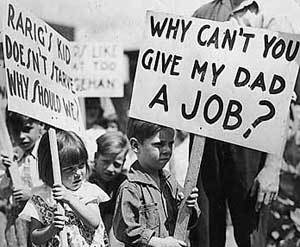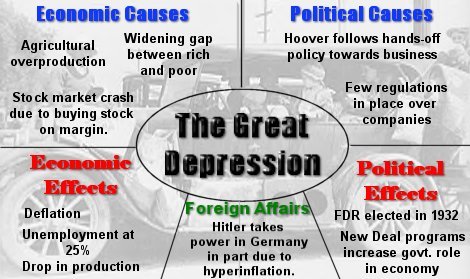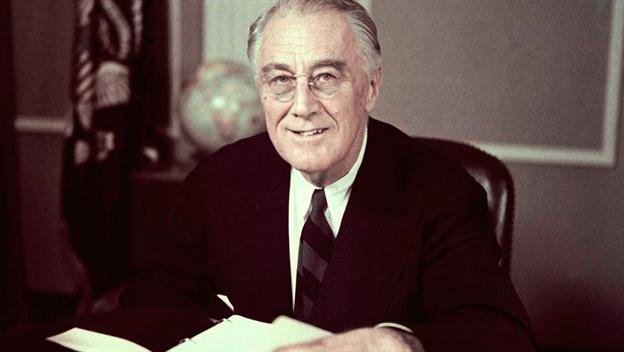GREAT DEPRESSION -History of USA #11
- INTRODUCTION
The Great Depression lasted from 1929 to 1939, and was the worst economic downturn in the history of the industrialized world. It began after the stock market crash of October 1929, which sent Wall Street into a panic and wiped out millions of investors.

- BACKGROUND
When Herbert Hoover was inaugurated as the thirty-first president of the US in March 1929, it seemed to most Americans that the economy was thriving. US business was growing, manufactured goods and raw materials flowed from the United States to the rest of the world, and technology was developing at an impressive rate. In reality there were weaknesses in the system, and the nation soon collapsed into the Great Depression.

Herbert Hoover, 31st President of the United States
- THE GREAT CRASH OF 1929
In the wake of the stock market crash, the US economy crumbled. The stock market collapsed following Britain's decision to raise the rates of interest to six and half percent. Once the prices fell in stock market, the speculator started selling their stock in bulk to avoid losses. As a result selling went on an ever increasing rate. On October 24, 1929 alone 13,000,000 shares were sold.

Daily Mail Reports the Great Crash of 1929
American industrial production decreased rapidly, and employment reached a staggering low. Up to 25 percent of the working population was unemployed at one point. For farmers, crop prices dropped drastically. People could not afford the basic needs of food and shelter.
As a result of the Wall Street crash an unparalleled depression overtook the US.
- Prices started falling sharply
- Foreign trade declined
- Construction ceased
- Wages were cut short
- Factories reduced production
- Real estate values declined
- Unemployment became rampant
- Seven million people unemployed in the year 1930
- HOOVERVILLES
Most citizens were unaware of the weaknesses of the system and economic conditions of the country. They blamed the new president for the onset of the Great Depression. Though Hoover worked to alleviate the nation's economic hardships, he was also against providing direct assistance to the unemployed. He believed that such assistance would result in laziness. By 1931 thousands of people had become unemployed and homeless. Shantytowns began to appear throughout the country, mostly within the inner cities, where people built makeshift homes.
They built their homes out of cardboard, tin, crates, scrap lumber and other discarded materials. These communities were quickly dubbed "Hoovervilles." The residents of Hoovervilles often assembled simple governments of their own, electing a mayor, city council, and police chief. People used Hoover's name to label other aspects of the experiences of the poor. When a jobless person wrapped a newspaper around him for warmth, the paper was called a Hoover blanket. When a broken down automobile was being towed away bu mules, it was a Hoover wagon. A man would turn an empty pocket inside out and call it a Hoover flag. Jackrabbits were called Hoover hogs by people who could not afford pork products.
In this situation breadlines and soup kitchens kept many from starving. Thousands of unemployed people took to the roads in search of work where they could find it. The desperate economic conditions quickly affected the rest of the world. Businesses and investors who lost either their money or their confidence withdrew foreign investments. This led the already rickety European economy to collapse, which placed an even greater strain on US businesses and banks. The entire industrialized world was in a downward economic spiral.
- CAUSES OF GREAT DEPRESSION

Following were some of the main causes of Great Economic Depression:
- Weak form economy
- Overproduction of industry product
- Uneven distribution of wealth
- Introduction of automation in industry
- Aftermath of World War I
- Decline in International trade due to high tariffs
- Stock Market Speculation
- Excessive use of credit
- Drought in Mississippi Valley
- Government Policy
- Disappearance of Western Frontier
- Inter-Government Tax
OTHER FACTORS:
Bruce W. Jentelson. the author of American Foreign Policy book is holder of various prestigious prize honors of Europe and America. He said that there are some other factors such as:
i) The increase in population rate was much less than production rate, which reduced the consumers.
ii) The disappearance of Western frontier which meant that America could no longer move in that direction during bad times.
iii) Political unrest in Europe, Asia and South America.
- IMPACT OF GREAT DEPRESSION
- Unemployment
- Homelessness
- Poverty
- Increased difficulties for farmers and Africans
- People's faith in Democracy and Capitalism was shaken
- They began to like an idea of a planned economy and classless society
- A lot of Americans converted to Socialism and Communism
- Politically Republican domination came to end and Democrats reaped the fruit of victory
- Banks and financial institutions were in great trouble due to buy-now-pay-later policy. In 1929 when banks were unable to recover their money, they increased the interest rate. Prices were also increased. Investors had withdrawn their money
- Debt was raised unimaginably, wages were cut down approximately to 20%. 25% of the total work force was unemployed
- GDP fell down about 40% in that year
- Dollar was devalued but debt remained the same
- Farm prices were also shrunk drastically
- Families split up & migrated from their homes in search of work
- ATTEMPTED REMEDIES BY PRESIDENT HOOVER
For the first two years of the Great Depression, President Hoover relied on the voluntary cooperation of business and labor to maintain payrolls and production. He encouraged them to foster industrial expansion, avoid strikes, share work when possible, stabilize prices, and provide relief where needed. He stressed that there must not be drastic wage cuts. At first, it seemed that this approach would work. When the crisis deepened, however, Hoover took positive steps to stop the spread of economic collapse. His best effort was the creation of Reconstruction Finance Corporation (RFC). The RFC functioned as a loan agency to aid large businesses, such as banks, railroads and insurance companies. Hoover supported laws, such as Home Loan Bank Act (1932), to aid people at risk of losing their homes and farms to the banks from which they borrowed to purchase them.
The Emergency Relief and Construction Act (1932) provided money for local relief loans and public works. Hoover had his limits, however, and refused to support direct federal aid to the unemployed. Believing that it would lower wages to a bare minimum and reward laziness, he insisted that helping the unemployed was the responsibility of local, not federal agencies. Though Hoover is widely regarded at a do-nothing president, he worked hard to fix the nation's woes. His successor, President Franklin D. Roosevelt, would get the credit for really helping the nation, though he built upon many of Hoover's programs and ideas.
- ROOSEVELT AND THE NEW DEAL
When Roosevelt took office in March 1933, the nation was in the depth of Great Depression. Millions of people struggled to survive everyday and the nation's economy weakened. With the economic crisis at its heights, Roosevelt immediately dedicated himself to create a flood of legislation aimed at relief, reform and recovery. Many of these programs were introduced during the first few months of Roosevelt's term, referred to as The Hundred Days. Roosevelt's advisers, known as the "brain trust," worked to establish the overall domestic policy that is known as the New Deal. The most influential pieces of legislation from both waves of the New Deal were aimed at providing relief, recovery and reform to the United States.

President Franklin D. Roosevelt
As the government accepted a much greater responsibility for the general welfare of its citizens and the regulation of the economy, Roosevelt restored a measure of confidence to the country. In 1937, however, the economy experienced another recession, and Roosevelt was moved to introduced more legislation. This is sometimes called his Second New Deal. Opponents of Roosevelt's New Deal feared that it amounted to communism.
- POSITIVE STEPS TAKEN BY ROOSEVELT
Many of the programs that were introduced during Roosevelt's presidency still exist today. Though not at all of Roosevelt's New Deal legislation was effective or long lasting, the progressive ideas served to restore American optimism.
RELIEF MEASURES
Relief measures included programs that were designed by the president to assist farmers and unemployed workers who faced impossible financial challenges. They included the following legislation:
- Federal Emergency Relief Administration (FERA 1933)
- Agricultural Adjustment Act (May 1933)
- Role of Supreme Court
- Soil Conservation & Domestic Allotment Act (1936)
- Civilian Conservation Corps (CCC 1934)
- Works Progress Administration (WPA 1935)
REFORM MEASURES
Reform measures were designed by the president to protect consumers by regulating businesses and providing assistance to the elderly and unemployed. They included the following legislation:
- Truth in Securities Act (1933)
- Glass-Steagall Act (1933)
- National Industrial Recovery Act (1933)
- Securities and Exchange Commission (SEC 1934)
- National Labor Relations Act (Wagner Act 1935)
- Social Security Act (SSA 1935)
- Fair Labor Standards Act (1938)
RECOVERY MEASURES
Roosevelt designed recovery measures to normalize economic activity and to restore faith in the banking system. They included the following legislation:
- Emergency Banking Act (1933)
- National Industrial Recovery Act (1933)
- Tennessee Valley Authority (TVA 1933)
- Resettlement Administration (1935)
- THE FINAL RECOVERY
By early 1937 there were definite signs of recovery. It was obvious that Roosevelt's New Deal legislation had eased much of nation's distress. The economy, however, experienced another sharp decline, almost as bad as in 1929. Though conditions improved again by mid-1938, it was the onset of the World War II that brought an end to the Great Depression.
- LEGACY OF THE NEW DEAL
President Roosevelt's New Deal allowed the federal government to assume new responsibility for the welfare of the people. In some cases, the Supreme Court decided New Deal programs were unlawful. Other programs were meant to provide just temporary relief in the midst of the Great Depression. The New Deal helped alleviate the problems caused by Great Depression. The depression did not end, however, until the American economy recovered by providing equipment and supplies for World War II.
- GREAT SOCIETY
In his State of the Union message, President Lyndon B. Johnson announced the Great Society he envisioned for the United States. Johnson's Great Society encompassed civil rights for minorities, an end to poverty, improved educational opportunities for all, improved healthcare for the poor and the aged, an improved quality of life in the cities, protection for consumers, conservation and environmental regulation.
- CRITICAL ANALYSIS
Great Depression was a worldwide economic downturn that began in 1929 and lasted until about at 1939. It was the longest and most severe depression ever experienced by the industrialized Western world, sparking fundamental changes in economic institutions, macroeconomic policy, and economic theory. Although it originated in the United States, the Great Depression caused drastic declines in output, severe unemployment and acute deflation in almost every country of the world. Its social and cultural effects were no less staggering, especially in the United States, where the Great Depression represented the harshest adversity faced by the Americans since the Civil War.
Congratulations! This post has been upvoted from the communal account, @minnowsupport, by fatimaa from the Minnow Support Project. It's a witness project run by aggroed, ausbitbank, teamsteem, theprophet0, someguy123, neoxian, followbtcnews/crimsonclad, and netuoso. The goal is to help Steemit grow by supporting Minnows and creating a social network. Please find us in the Peace, Abundance, and Liberty Network (PALnet) Discord Channel. It's a completely public and open space to all members of the Steemit community who voluntarily choose to be there.
This post has received a 0.28 % upvote from @drotto thanks to: @banjo.
Plagiarism.
Uncited cut and paste:
http://www.history.com/topics/great-depression